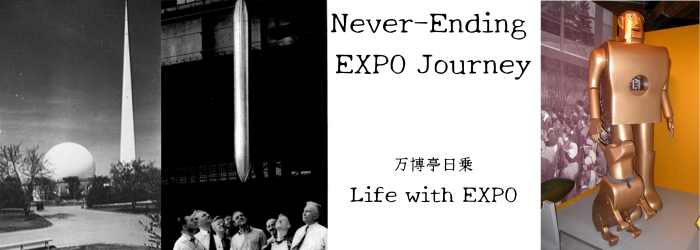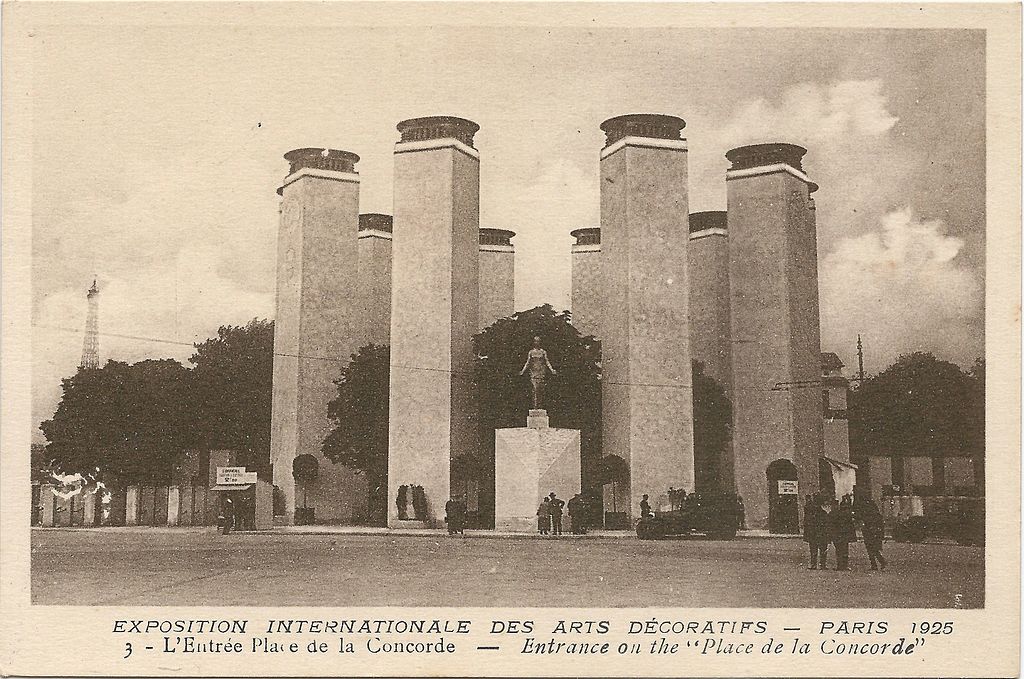1925 Paris “Art Deco Expo”
As introduced in <19>, Marie Laurencin (1883 – 1956) contributed a painting to the “Art Deco Expo” that caused a great deal of publicity.
What kind of Expo was this Art Deco Expo?
Basic information looks like this:
(Decorative Arts and Modern Industry World Expo)
Dates: April 30-October 15, 1925
Venue: Paris. 28.8 ha.
The existing exhibition halls such as the Grand Palais and the Petit Palais, which were donated to the city of Paris after the 1900 World Exposition, were used. Other temporary structures were set up on both banks of the Seine. A Venetian-style shopping street was set up on the Alexander III Bridge, which was built for the 1900 Paris World Exposition. The venue extended to Les Invalides.
Participating countries: 22
Number of visitors: 15.99 million
By the way, I checked the homepage of BIE (Bureau International des Expositions), but there was no information about this Expo.
There is information on smaller expos, but I don’t know why this expo is not listed.
In addition, there is also a document stating that the number of visitors was 14 million.
This data is not unified by the materials, but it is a common story especially about the old World Expositions.
This Expo is often referred to as the “Art Deco Expo” in Japan, but the name “Arts Deco” was named after the abbreviation of the French name of the Expo, “Exposition Internationale des Arts Décoratifs et Industriels Modernes.” This Expo caused the “Art Deco” style became popular internationally.
However, it seems that the term “Art Deco” did not become popular during the period of the exposition, but came to be called such after the Second World War.
At the time of the Expo, it was called “Art Moderne” (modern art).
Partly because of this, not all the works exhibited at the Expo were “Art Deco style”, and it seems that the Art Deco style did not dominate the Expo as a whole.
The first World Exposition was held in Paris in 1855 and the second in 1867. There was an interval of 12 years during this period, but after that, the next Paris World Expos were held in 1878, 1889, and 1900, every 11 years.
If that is the case, the next time would be 1911, but the Paris World Exposition was not held in 1911.
In fact, the French government was initially planning to hold the World Exposition in 1915.
However, due to various circumstances such as the First World War (1914-1918), it was decided to hold the event in 1925, 10 years later than originally planned. It was not until 1921 that the operating funds for the exposition were allocated.
The French government intended to restore France to its status as a referee of the styles of industrial and decorative arts in the post-World War I turmoil. In terms of art as an industry, Italy and Germany were leading the way, and France was trying to regain its initiative.
There are various theories, but the 1900 Paris World Exposition was an exposition that symbolized “Art Nouveau,” and the motif of “Art Nouveau,” characterized by plants and their curves, was later influenced by the Cubist movement. And under the influence of ancient Egyptian culture, represented by the tomb of Tutankhamun, which was discovered in 2023, it transformed into a geometric and linear style and became the style of “Art Deco”.
So while Art Deco is partly curvilinear, the straight lines also stand out.
In addition, the aspect of industrial art was also important, so one of the characteristics of this Expo was that several department stores that dealt with it as a business also exhibited their pavilions.
For example, the Louvre (Louvre department store) pavilion, Galeries Lafayette pavilion, Au Printemps pavilion, Bon Marche pavilion, etc.
These department stores have large pavilions at Les Invalides.
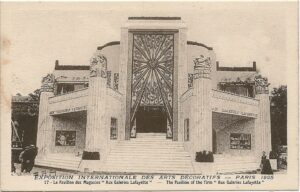
1925年「アール・デコ博」
ギャルリー・ラファイエット館
Expo 1925 Arts décoratifs
Pavillon des Galeries Lafayette
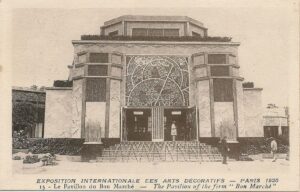
1925年「アール・デコ博」
ボン・マルシェ館
Expo 1925 Arts Décoratifs
Bon Marché Pavilion
There are 22 participating countries.
Japan participated, but the United States and Germany did not.
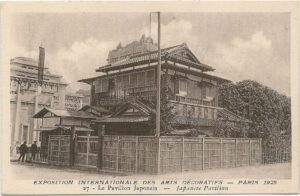
1925年「アール・デコ博」日本館
Expo 1925 Arts Décoratifs, Japan Pavilion
Germany was a defeated country in World War I, which may be the reason.
In 1924, France invited the United States to this World Expo, but Herbert Hoover, then Secretary of Commerce, turned it down.
This Herbert Hoover (1874 – 1964), who later became the 31st President of the United States, donated $50,000 to Stanford University for the establishment of the Hoover Institute. It is a person who has left his name in the “Hoover Tower” , which is still on the campus of Stanford University.
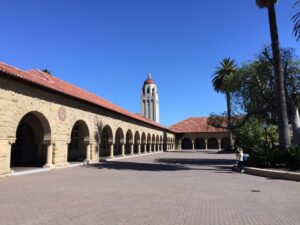
スタンフォード大学キャンパス
奥に立つのがフーバー・タワー
Stanford University campus
Hoover Tower in the background
His reason for refusing to participate in the 1925 Art Deco Expo was apparently that he thought “there is no modern decorative arts movement in America.”
However, many Americans visited this “Art Deco Expo” although the United States did not officially participate as a country.
In 1926, the year after the Expo, an exhibition of 400 works from the “Art Deco Exposition” in Paris, sponsored by the Association of American Art Museums, toured the United States.
This led to the American-style “Art Deco” movement becoming very popular in the United States.
The Chrysler Building (1930) and the Empire State Building (1931) in New York are well-known examples of American Art Deco. Both were once the tallest buildings in the world.
Manhattan still has many “Art Deco” buildings as of today.
In Japan, for example, the Teien Art Museum in Tokyo is famous for its architecture incorporating the Art Deco style (former Prince Asaka Residence, 1933).
The glass relief door of the main entrance is an art deco work by French glass artist and jewelry designer René Lalique (1860 – 1945).
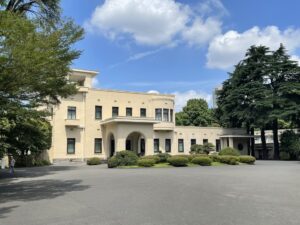
庭園美術館
Tokyo Metropolitan Teien Art Museum
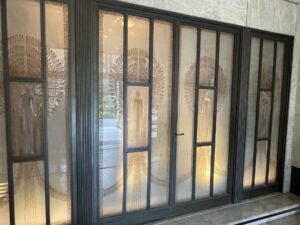
ルネ・ラリックのガラスレリーフ
Glass Relief by René Lalique
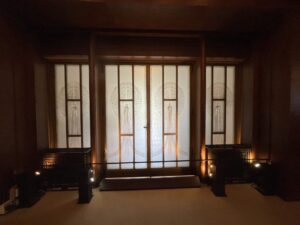
ルネ・ラリックのガラスレリーフ(室内から)
Glass Relief by René Lalique (From Inside)
Rene Lalique is an artist who lived in both the “Art Nouveau” and “Art Deco” eras. At the 1900 Paris Exposition, he exhibited jewelry and other items.
And at this 1925 Art Deco Exposition, one pavilion was given to Lalique.
Lalique exhibited the “Lalique Pavilion” in the Les Invalides venue, and also installed the “Lalique Fountain” in the square in front of it. This “Lalique’s Fountain” has a photograph, and water is projected diagonally downward at the same time from each block-like place with 15 layers.
This picture remind me of the fireworks of “Taipei 101” in Taiwan.
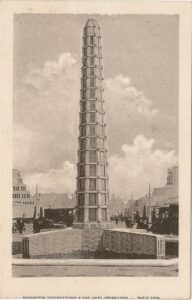
1925年「アール・デコ博」
ルネ・ラリックの噴水
Expo 1925 Arts Décoratifs
Fountain by René Lalique
At the 1925 Art Deco Exposition, the architect Le Corbusier (1887 – 1965) created the “L’Esprit Nouveau (new spirit) Pavilion”, which got a great reputation. Le Corbusier was an architect from Switzerland, famous for the National Museum of Western Art in Tokyo (registered as a World Cultural Heritage Site in 2016) and the Chapel of Ronchamp in France, and was also active as a painter.

国立西洋美術館
The National Museum of Western Art
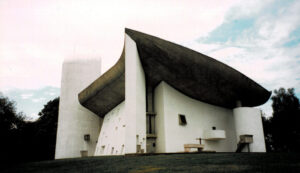
ル・コルビュジエ「ロンシャンの礼拝堂」
Le Corbusier “The Chapel of Notre Dame du Haut at Ronchamp”
This modernist architectural work, the “L’Esprit Nouveau Pavilion”, was a rather bold design for the time, and was not generally accepted. It was said that it was hidden behind a fence.
I still have a photo of this “L’Esprit Nouveau Pavilion”, but looking at it now, I don’t think it’s a design so radical to be hidden. It has a modern design anyway. The design is like a square box centered on straight lines, and you can see concrete (I think it is) and square glass windows.
And next to it, in a piloti-like area, there is a large tree that protrudes into the sky from the circular cutout of the ceiling. I wonder if this design was made because they didn’t want to cut down this tree.
It seems that this spirit is similar to the design of the ceiling of the Crystal Palace, which was rounded to avoid having to cut down the large elm tree in Hyde Park for the 1851 London Great Exhibition.
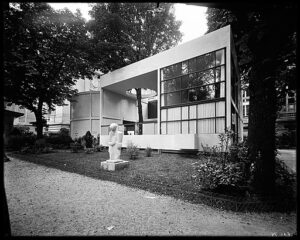
1925年「アール・デコ博」
「エスプリ・ヌーヴォー館」
Expo 1925 Arts Décoratifs
L’Esprit Nouveau Pavilion
In addition, the Pavilion of the Soviet Union (1922 – 1991) was entrusted to Konstantin Melnikov (1890 – 1974), an architect from the suburbs of Moscow. This pavilion also makes extensive use of straight lines, and there is a record that it attracted the attention of the world along with Le Corbusier’s “L’Esprit Nouveau Pavilion”.
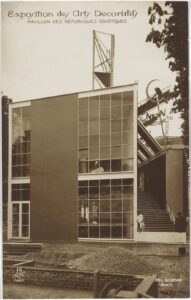
1925アール・デコ博 ソ連館
1925 Art Deco Expo USSR Pavilion
There is also a photograph, but it looks like just a modernist architecture. I think it’s still a novel design, but it’s not that surprising. However, it can be imagined that it was a considerably avant-garde design at that time. It is no wonder that it attracted attention.
By the way, the architect Le Corbusier, who worked on the “L’Esprit Nouveau Pavilion”, will appear at the World Exposition after the “Art Deco Exposition” in 1925 and provide a topic, but that is another story.
Let me take this as another opportunity to introduce to you.
